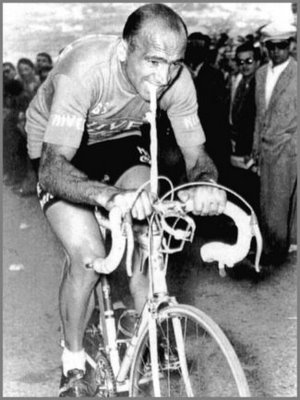Raphael Geminiani
 Mon, October 1, 2018
Mon, October 1, 2018  Raphael Geminiani was born in France on July 12, 1925.
Raphael Geminiani was born in France on July 12, 1925.
His parents were Italian immigrants who had moved to France in 1920 to escape Fascism.
Although he never won a Grand Tour, he stood on the podium of all three Grand Tour events, a total of six times.
He was second to Hugo Koblet in the 1951 Tour de France, and also won the King of the Mountains title that year.
Geminiani was also 3rd in the 1958 Tour de France behind Charly Gaul of Luxembourg and Vito Favero of Italy.
He won the Mountains Jersey in the Giro d’Italia in 1952 and 1957.
In addition, Geminiani was 3rd in the 1955 Vuelta a Espana behind Jean Dotto of France and Antonio Jimenez of Spain.
He raced in an era of other great riders such as Fausto Coppi, Gino Bartali, Louison Bobet, and Jean Robic.
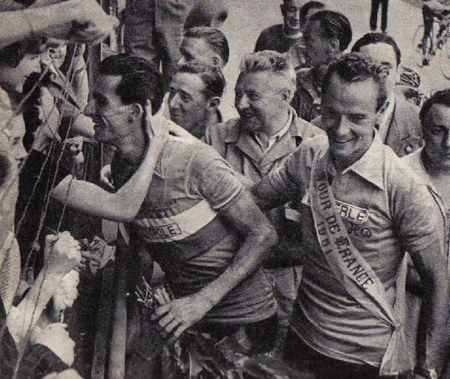 Above: At the finish of the 1951 Tour de France in Paris. Raphael Geminiani (Left.) 2nd. Place, and King of the Mountains. With the winner Swiss rider Hugo Koblet (Right.)
Above: At the finish of the 1951 Tour de France in Paris. Raphael Geminiani (Left.) 2nd. Place, and King of the Mountains. With the winner Swiss rider Hugo Koblet (Right.)
Raphael Geminiani grew up with a cycling background, his father owned a bike shop, and coached the young Raphael when he started racing in 1943. This was during the German occupation of France in WWII, when cycle races were still held.
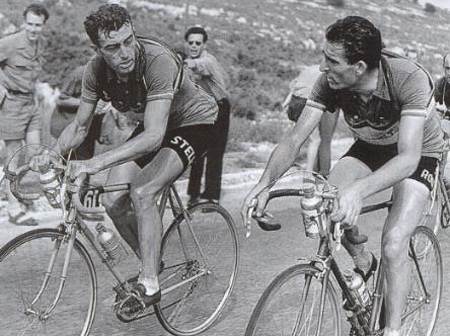
Geminiani began his cycle racing career as an amateur at the same time as the other great French rider Louison Bobet. The two were sometimes on the same team, but more often than not were great rivals. Pictured together above with Bobet on the left.
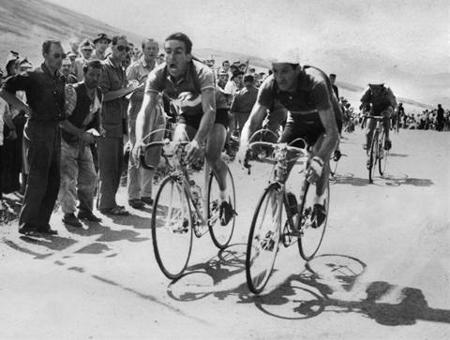 (Above.) Raphael Geminiani narrowly outsprints Italian Gino Bartali to win the 21st stage of the 1952 Tour de France. Alltogether he won seven stages of the TDF between 1949 and 1955 and wore the yellow leader's jersey for four days.
(Above.) Raphael Geminiani narrowly outsprints Italian Gino Bartali to win the 21st stage of the 1952 Tour de France. Alltogether he won seven stages of the TDF between 1949 and 1955 and wore the yellow leader's jersey for four days.
When Geminiani retired as a professional cyclist in 1960 he became a successful directeur sportif, notably of Jacques Anquetil and the St-Raphaël team. Anquetil was the first to win the Tour de France five times.
Raphael Geminiani also co-sponsored the St. Raphael Team, and marketed a line of Geminiani brand of bicycles that were built by the French Mercier bicycle manufacturer.
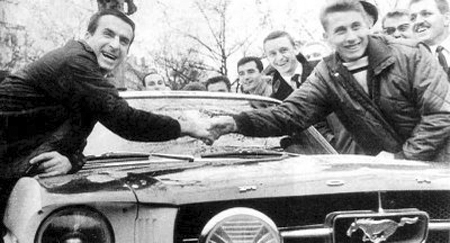 Above: Raphael Geminiani with Jacques Anquetil on the right.
Above: Raphael Geminiani with Jacques Anquetil on the right.
In 1953 Geminiani rode for Fausto Coppi on his Bianchi Team, the two were lifelong friends. In late 1959 Raphael was part of a group that went on a hunting trip to Africa.
He shared a room with Fausto Coppi and the two contracted malaria. Geminiani returned to France and although seriously ill, he was correctly diagnosed, treated, and made a full recovery.
Fausto Coppi however, was miss-diagnosed by his Italian doctors and as a result died. He was only forty years old.
Raphael Geminiani was a hero of my teen years when I started racing in the 1950s. He turned 93 this year is one of the few living connections to the legends of that great era of cycling. He once stated, “There is not a day goes by that I do not think of Fausto Coppi.”







































